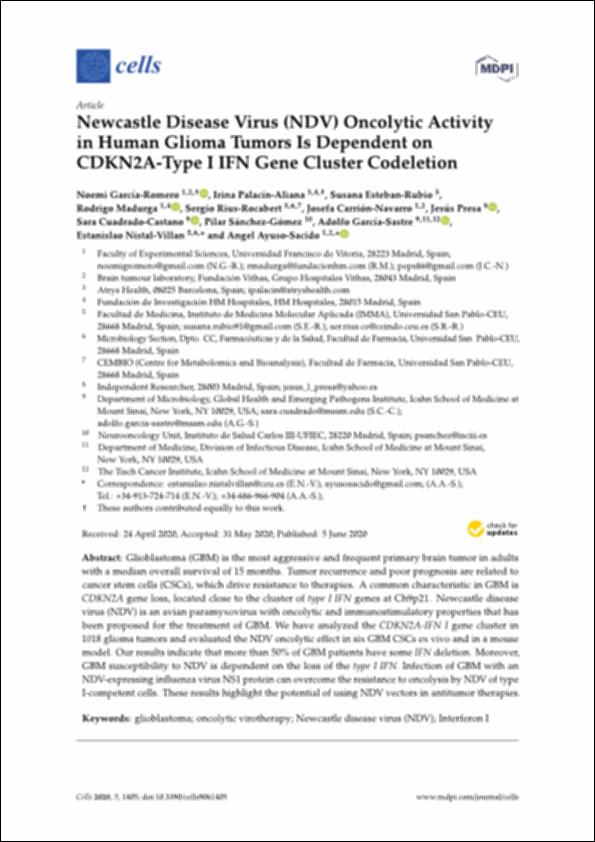Por favor, use este identificador para citar o enlazar este ítem:
http://hdl.handle.net/10637/15339Newcastle disease virus (NDV) oncolytic activity in human glioma tumors is dependent on CDKN2A-Type I IFN gene cluster codeletion
| Título : | Newcastle disease virus (NDV) oncolytic activity in human glioma tumors is dependent on CDKN2A-Type I IFN gene cluster codeletion |
| Autor : | García Romero, Noemí Palacín Aliana, Irina Esteban Rubio, Susana Madurga, Rodrigo Rius Rocabert, Sergio Carrión-Navarro, Josefa Presa, Jesús Cuadrado Castano, Sara Sánchez Gómez, Pilar García Sastre, Adolfo Nistal Villán, Estanislao Ayuso Sacido, Ángel |
| Materias: | Glioblastoma; Oncolytic virotherapy; Newcastle disease virus (NDV); Interferon I |
| Editorial : | MDPI |
| Citación : | García-Romero, N., Madurga, R., Carrión-Navarro, J., Ayuso-Sacido, A., Palacín-Aliana, I., Esteban-Rubio, S., Rius-Rocabert, S., Nistal-Villan, E., Presa, J., Cuadrado-Castano, S., García-Sastre, A., & Sánchez-Gómez, P. (2020). Newcastle Disease Virus (NDV) Oncolytic Activity in Human Glioma Tumors Is Dependent on CDKN2A-Type I IFN Gene Cluster Codeletion. Cells, 9(6). https://doi.org/10.3390/cells9061405 |
| Resumen : | Glioblastoma (GBM) is the most aggressive and frequent primary brain tumor in adults with a median overall survival of 15 months. Tumor recurrence and poor prognosis are related to cancer stem cells (CSCs), which drive resistance to therapies. A common characteristic in GBM is CDKN2A gene loss, located close to the cluster of type I IFN genes at Ch9p21. Newcastle disease virus (NDV) is an avian paramyxovirus with oncolytic and immunostimulatory properties that has been proposed for the treatment of GBM. We have analyzed the CDKN2A-IFN I gene cluster in 1018 glioma tumors and evaluated the NDV oncolytic e ect in six GBM CSCs ex vivo and in a mouse model. Our results indicate that more than 50% of GBM patients have some IFN deletion. Moreover, GBM susceptibility to NDV is dependent on the loss of the type I IFN. Infection of GBM with an NDV-expressing influenza virus NS1 protein can overcome the resistance to oncolysis by NDV of type I-competent cells. These results highlight the potential of using NDV vectors in antitumor therapies. |
| URI : | http://hdl.handle.net/10637/15339 |
| Derechos: | http://creativecommons.org/licenses/by-nc-nd/4.0/deed.es |
| ISSN : | 2073-4409 |
| Fecha de publicación : | 2020 |
| Centro : | Universidad San Pablo-CEU |
| Aparece en las colecciones: | Facultad de Farmacia |
Los ítems de DSpace están protegidos por copyright, con todos los derechos reservados, a menos que se indique lo contrario.


